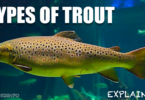The most feared apex predator of the ocean, the great white shark, is an interesting species. Though it has got killer intentions for humans, it still is one of the trophy specie about which people want to know. Several studies have been made to know more and more about great white sharks. Here, we are going to share the species profile and some interesting facts about them.
The Great White Shark – Species Profile
Scientific name: Carcharodon carcharias
Taxonomic Classification

Physical Appearance
Great white sharks are grey or bluish in color, with white underbellies. They have a conical snout, which is quite pointed, and sharp teeth, aiding them in feeding habits. Their bodies are torpedo-shaped which allows them to move in the ocean at a high speed, making them one of the agile predators of the ocean.

Size and Weight
Great white sharks, when reaching maturity, weigh around 4000 – 5000 pounds. They can grow as long as 15 feet on average, but some specimens do reach the length of 20 feet.
Habitat / Geographical Distribution
The young ones of great white sharks prefer shallow waters to avoid deep-sea predators, while the adult shark can be found either near the shore or deep in the ocean. They are widely distributed in all the oceans of the world but are mostly spotted near the coastal regions of California, South Australia, South Africa, Japan, Chile, and the Mediterranean Sea.

Diet
Great white sharks are known for their predatory behavior and being giant in size, they surely feed a lot. As juveniles, they feed on small crustaceans, rays, and small fish. When they turn into adults, they like to prey on seals, whales, dolphins, and other fish. They have a diverse diet as sometimes they have been observed feeding on crustaceans as well, at an adult stage.

Great white sharks can eat humans as well, though they do not prefer it.
Reproduction
Great white sharks reproduce via an ovoviviparous mode of reproduction. Following this method, they give birth to young pups; females keep the fertilized embryo inside their bodies. These embryos feed on the yolk sacs for nourishment and grow into young pups. After birth, the young one is self-sufficient and is not cared for by the mother shark.
Conservation Status
The species recovery score has slightly increased in the previous years, thus, researchers believe that the population of the Great white sharks is Moderately Depleted (MD). However, more studies need to be done in this regard as future threats are yet to be considered.
Great White Shark – Interesting Facts
Let’s explore some interesting facts about great white sharks.
1: The coloration of great white sharks’ bodies gives them an advantage over other animals in the ocean. The countershading of their body which is grey and white, helps them blend in the ocean, thus, they remain undetected both by prey and the predator.
2: Great white sharks are found everywhere in the world, except in the oceans of Antarctica.
3: They are the largest predatory animal in the ocean and are often known as massive killers. They latch on their prey with a strong bite force of 4,000 psi.
4: Great white sharks’ bulky bodies do not stop them from becoming one of the fastest animals in the ocean. They are known to have a swim speed of 25-35 mph.
5: Though great white sharks are known as man-eating animals, they do not like to consume humans. According to the studies made, great white sharks usually mistake humans for other prey and just try to have a sample bite. Unfortunately, their sample bite is lethal enough to kill a human.
6: Well, these sharks like to bite on anything. They even bite boats roaming in the ocean and become the reason for the boat sinking.
7: Great white sharks have very strong senses, making them one of the most intelligent marine creatures. They are able to detect the smell of blood from miles away.
8: The presence of reflective cells behind their retina allows them to see clearly in the dark, and if you look at their eyes in the dark, you’ll observe them glowing.
9: Like some other sharks, great white sharks also show leaping behavior. They can fly high in the air as much as 10 feet.

10: These mighty predators get preyed upon by their only natural predators, killer whales or also known as Orcas.
11: Great white sharks employ “electroreception” to detect the electric fields generated by animals in the ocean.
12: While mating, the male great white sharks grab the female in between their teeth and inseminate them.
13: When they get attacked, they have a special ability to roll their eyes back into their heads, thus, protecting them from any damage.
14: Great white sharks are notorious predators who prefer to hunt in the early morning.
15: Great white sharks have around 300 or more teeth, which are sharp like razors, cutting the flesh of the prey.
16: The young pups, growing inside the mother’s womb feed on the other small embryos, depicting cannibalistic behavior.
17: Although great white sharks have strong bite force, the rate of human fatality is comparatively low.
18: Great white sharks prefer to stay alone, but sometimes, they do spend a significant amount of time with their partner.
19: To ensure that their feeding requirements are met, great white sharks even migrate to faraway areas.
20: When Great white sharks lay on their backs, they usually become motionless. This condition is called “tonic immobility.”
21: Great white sharks are not suitable to be kept in an aquarium. One reason is their size, the second reason is that they cannot stay for long in captivity as they will become disoriented, and eventually stop eating.
22: Great white sharks do not sleep but take a rest in intervals.
23: Great white sharks are one of the sharks that can control their body temperature, as they are warm-blooded.
24: A fight between two great white sharks on a meal is interesting to look at. Both sharks create splashes in the water with the help of their tails. The shark making more splashes in a short period of time wins the meal.
Bottom Line
Great white sharks are the apex predator of the ocean are warm-blooded, feed on seals and dolphins, and have worldwide distribution except for Antarctica. Their serrated teeth are responsible for several injuries and even death of people. However, humans also pose a great deal of threat to their existence, and conservation measures need to be taken in this regard.

![The Great White Shark [20+ Facts] Reproduction, Habitat, Size & Diet](https://sharksinfo.com/wp-content/uploads/2023/01/Great-White-Shark-810x456.jpg)





